
如何才能给微信公众号增加更多功能?传统的做法是使用一台服务器搭建微信公众号的后台服务,那么我们能否利用 Serverless 架构,通过超简单的方法来实现简单的微信公众号后台?
初步搭建
Serverless 原生开发
首先需要提前准备一个微信公众号,然后为函数计算服务申请固定 IP:


点击白名单之后就可以填写表单,完成固定公网出口 IP 的申请。
接下来就是代码开发。
依据参考文档,将函数绑定到公众号后台:
我们可以先在函数中按照文档完成一个基本的鉴定功能:
def checkSignature(param): ''' 文档地址:https://developers.weixin.qq.com/doc/offiaccount/Basic_Information/Access_Overview.html :param param: :return: ''' signature = param['signature'] timestamp = param['timestamp'] nonce = param["nonce"] tmparr = [wxtoken, timestamp, nonce] tmparr.sort() tmpstr = ''.join(tmparr) tmpstr = hashlib.sha1(tmpstr.encode("utf-8")).hexdigest() return tmpstr == signature
再定义一个基本的回复方法:
def response(body, status=200): return { "isBase64Encoded": False, "statusCode": status, "headers": {"Content-Type": "text/html"}, "body": body }
函数入口处:
def main_handler(event, context): if 'echostr' in event['queryString']: # 接入时的校验 return response(event['queryString']['echostr'] if checkSignature(event['queryString']) else False)
配置 Yaml:
# serverless.ymlWeixin_GoServerless: component: "@serverless/tencent-scf" inputs: name: Weixin_GoServerless codeUri: ./Admin handler: index.main_handler runtime: Python3.6 region: ap-shanghai description: 微信公众号后台服务器配置 memorySize: 128 timeout: 20 environment: variables: wxtoken: 自定义一个字符串 appid: 暂时不写 secret: 暂时不写 events: - apigw: name: Weixin_GoServerless parameters: protocols: - https environment: release endpoints: - path: / method: ANY function: isIntegratedResponse: TRUE
执行代码,完成部署:
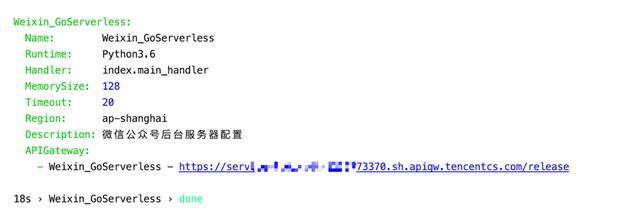
在众号后台选择基本配置:
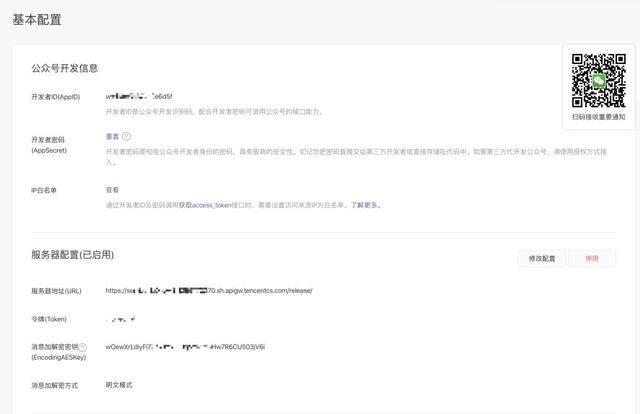
选择修改配置:
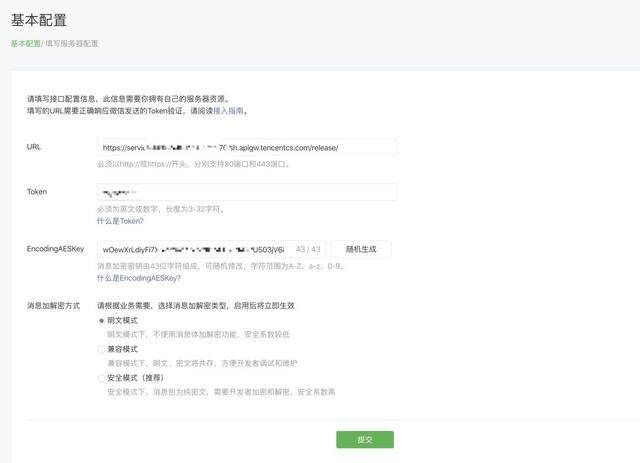
需要注意的是:
URL,写部署完成返回的地址,并且在最后加一个/
Token,写Yaml中的wxtoken,两个地方要保持一样的字符串
EncodingAESKey,点击随机生成
消息加密方法可以选择明文
完成之后,点击提交:

看到提交成功,就说明已经完成了第一步骤的绑定,接下来,我们到函数的后台:

打开这个固定出口 IP,复制 IP 地址:
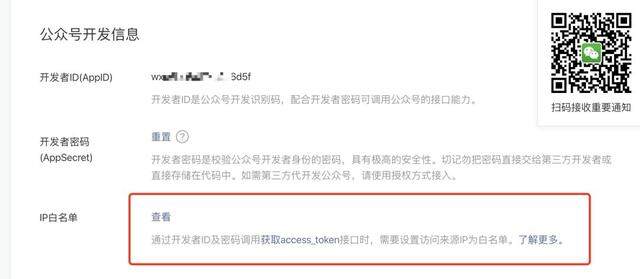
点击查看->修改,并将 IP 地址复制粘贴进来,保存。
同时查看开发者 ID 和密码:
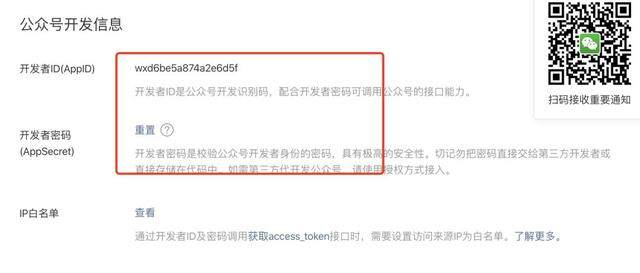
并将这两个内容复制粘贴,放到环境变量中:

至此,我们就完成了一个公众号后台服务的绑定。为了方便之后的操作,先获取一下全局变量:
wxtoken = os.environ.get('wxtoken')appid = os.environ.get('appid')secret = os.environ.get('secret')
接下来对各个模块进行编辑(本文只提供部分简单基础的模块,更多功能实现可以参考微信公众号文档实现)
获取AccessToken模块:
def getAccessToken(): ''' 文档地址:https://developers.weixin.qq.com/doc/offiaccount/Basic_Information/Get_access_token.html 正常返回:{"access_token":"ACCESS_TOKEN","expires_in":7200} 异常返回:{"errcode":40013,"errmsg":"invalid appid"} :return: ''' url = "https://api.weixin.qq.com/cgi-bin/token?grant_type=client_credential&appid=%s&secret=%s" % (appid, secret) accessToken = json.loads(urllib.request.urlopen(url).read().decode("utf-8")) print(accessToken) return None if "errcode" in accessToken else accessToken["access_token"]
创建自定义菜单模块:
def setMenu(menu): ''' 文档地址:https://developers.weixin.qq.com/doc/offiaccount/Custom_Menus/Creating_Custom-Defined_Menu.html 正确返回:{"errcode":0,"errmsg":"ok"} 异常返回:{"errcode":40018,"errmsg":"invalid button name size"} :return: ''' accessToken = getAccessToken() if not accessToken: return "Get Access Token Error"
url = "https://api.weixin.qq.com/cgi-bin/menu/create?access_token=%s" % accessToken postData = urllib.parse.urlencode(menu).encode("utf-8") requestAttr = urllib.request.Request(url=url, data=postData) responseAttr = urllib.request.urlopen(requestAttr) responseData = json.loads(responseAttr.read()) return responseData['errmsg'] if "errcode" in responseData else "success"
常见消息回复模块:
def textXML(body, event): ''' :param body: {"msg": "test"} msg: 必填,回复的消息内容(换行:在content中能够换行,微信客户端就支持换行显示) :param event: :return: ''' return """<xml><ToUserName><![CDATA[{toUser}]]></ToUserName> <FromUserName><![CDATA[{fromUser}]]></FromUserName> <CreateTime>{time}</CreateTime> <MsgType><![CDATA[text]]></MsgType> <Content><![CDATA[{msg}]]></Content></xml>""".format(toUser=event["FromUserName"], fromUser=event["ToUserName"], time=int(time.time()), msg=body["msg"])
def pictureXML(body, event): ''' :param body: {"media_id": 123} media_id: 必填,通过素材管理中的接口上传多媒体文件,得到的id。 :param event: :return: ''' return """<xml><ToUserName><![CDATA[{toUser}]]></ToUserName> <FromUserName><![CDATA[{fromUser}]]]></FromUserName> <CreateTime>{time}</CreateTime> <MsgType><![CDATA[image]]></MsgType> <Image> <MediaId><![CDATA[{media_id}]]></MediaId> </Image></xml>""".format(toUser=event["FromUserName"], fromUser=event["ToUserName"], time=int(time.time()), media_id=body["media_id"])
def voiceXML(body, event): ''' :param body: {"media_id": 123} media_id: 必填,通过素材管理中的接口上传多媒体文件,得到的id :param event: :return: ''' return """<xml><ToUserName><![CDATA[{toUser}]]></ToUserName> <FromUserName><![CDATA[{fromUser}]]></FromUserName> <CreateTime>{time}</CreateTime> <MsgType><![CDATA[voice]]></MsgType> <Voice> <MediaId><![CDATA[{media_id}]]></MediaId> </Voice></xml>""".format(toUser=event["FromUserName"], fromUser=event["ToUserName"], time=int(time.time()), media_id=body["media_id"])
def videoXML(body, event): ''' :param body: {"media_id": 123, "title": "test", "description": "test} media_id: 必填,通过素材管理中的接口上传多媒体文件,得到的id title::选填,视频消息的标题 description:选填,视频消息的描述 :param event: :return: ''' return """<xml><ToUserName><![CDATA[{toUser}]]></ToUserName> <FromUserName><![CDATA[{fromUser}]]></FromUserName> <CreateTime>{time}</CreateTime> <MsgType><![CDATA[video]]></MsgType> <Video> <MediaId><![CDATA[{media_id}]]></MediaId> <Title><![CDATA[{title}]]></Title> <Description><![CDATA[{description}]]></Description> </Video></xml>""".format(toUser=event["FromUserName"], fromUser=event["ToUserName"], time=int(time.time()), media_id=body["media_id"], title=body.get('title', ''), description=body.get('description', ''))
def musicXML(body, event): ''' :param body: {"media_id": 123, "title": "test", "description": "test} media_id:必填,缩略图的媒体id,通过素材管理中的接口上传多媒体文件,得到的id title:选填,音乐标题 description:选填,音乐描述 url:选填,音乐链接 hq_url:选填,高质量音乐链接,WIFI环境优先使用该链接播放音乐 :param event: :return: ''' return """<xml><ToUserName><![CDATA[{toUser}]]></ToUserName> <FromUserName><![CDATA[{fromUser}]]></FromUserName> <CreateTime>{time}</CreateTime> <MsgType><![CDATA[music]]></MsgType> <Music> <Title><![CDATA[{title}]]></Title> <Description><![CDATA[{description}]]></Description> <MusicUrl><![CDATA[{url}]]></MusicUrl> <HQMusicUrl><![CDATA[{hq_url}]]></HQMusicUrl> <ThumbMediaId><![CDATA[{media_id}]]></ThumbMediaId> </Music></xml>""".format(toUser=event["FromUserName"], fromUser=event["ToUserName"], time=int(time.time()), media_id=body["media_id"], title=body.get('title', ''), url=body.get('url', ''), hq_url=body.get('hq_url', ''), description=body.get('description', ''))
def articlesXML(body, event): ''' :param body: 一个list [{"title":"test", "description": "test", "picUrl": "test", "url": "test"}] title:必填,图文消息标题 description:必填,图文消息描述 picUrl:必填,图片链接,支持JPG、PNG格式,较好的效果为大图360*200,小图200*200 url:必填,点击图文消息跳转链接 :param event: :return: ''' if len(body["articles"]) > 8: # 最多只允许返回8个 body["articles"] = body["articles"][0:8] tempArticle = """<item> <Title><![CDATA[{title}]]></Title> <Description><![CDATA[{description}]]></Description> <PicUrl><![CDATA[{picurl}]]></PicUrl> <Url><![CDATA[{url}]]></Url> </item>""" return """<xml><ToUserName><![CDATA[{toUser}]]></ToUserName> <FromUserName><![CDATA[{fromUser}]]></FromUserName> <CreateTime>{time}</CreateTime> <MsgType><![CDATA[news]]></MsgType> <ArticleCount>{count}</ArticleCount> <Articles> {articles} </Articles></xml>""".format(toUser=event["FromUserName"], fromUser=event["ToUserName"], time=int(time.time()), count=len(body["articles"]), articles="".join([tempArticle.format( title=eveArticle['title'], description=eveArticle['description'], picurl=eveArticle['picurl'], url=eveArticle['url'] ) for eveArticle in body["articles"]]))
对main_handler进行修改,使其:
识别绑定功能
识别基本信息
识别特殊额外请求(例如通过url触发自定义菜单的更新)
整体代码:
def main_handler(event, context): print('event: ', event)
if event["path"] == '/setMenu': # 设置菜单接口 menu = { "button": [ { "type": "view", "name": "精彩文章", "url": "https://mp.weixin.qq.com/mp/homepage?__biz=Mzg2NzE4MDExNw==&hid=2&sn=168bd0620ee79cd35d0a80cddb9f2487" }, { "type": "view", "name": "开源项目", "url": "https://mp.weixin.qq.com/mp/homepage?__biz=Mzg2NzE4MDExNw==&hid=1&sn=69444401c5ed9746aeb1384fa6a9a201" }, { "type": "miniprogram", "name": "在线编程", "appid": "wx453cb539f9f963b2", "pagepath": "/page/index" }] } return response(setMenu(menu))
if 'echostr' in event['queryString']: # 接入时的校验 return response(event['queryString']['echostr'] if checkSignature(event['queryString']) else False) else: # 用户消息/事件 event = getEvent(event) if event["MsgType"] == "text": # 文本消息 return response(body=textXML({"msg": "这是一个文本消息"}, event)) elif event["MsgType"] == "image": # 图片消息 return response(body=textXML({"msg": "这是一个图片消息"}, event)) elif event["MsgType"] == "voice": # 语音消息 pass elif event["MsgType"] == "video": # 视频消息 pass elif event["MsgType"] == "shortvideo": # 小视频消息 pass elif event["MsgType"] == "location": # 地理位置消息 pass elif event["MsgType"] == "link": # 链接消息 pass elif event["MsgType"] == "event": # 事件消息 if event["Event"] == "subscribe": # 订阅事件 if event.get('EventKey', None): # 用户未关注时,进行关注后的事件推送(带参数的二维码) pass else: # 普通关注 pass elif event["Event"] == "unsubscribe": # 取消订阅事件 pass elif event["Event"] == "SCAN": # 用户已关注时的事件推送(带参数的二维码) pass elif event["Event"] == "LOCATION": # 上报地理位置事件 pass elif event["Event"] == "CLICK": # 点击菜单拉取消息时的事件推送 pass elif event["Event"] == "VIEW": # 点击菜单跳转链接时的事件推送 pass
在上述代码中可以看到:
if event["MsgType"] == "text": # 文本消息 return response(body=textXML({"msg": "这是一个文本消息"}, event))elif event["MsgType"] == "image": # 图片消息 return response(body=textXML({"msg": "这是一个图片消息"}, event))
当用户发送了文本消息时,我们给用户回复一个文本消息:“这是一个文本消息”,当用户发送了一个图片,我们给用户返回“这是一个图片消息”,用这两个功能测试后台的连通性:
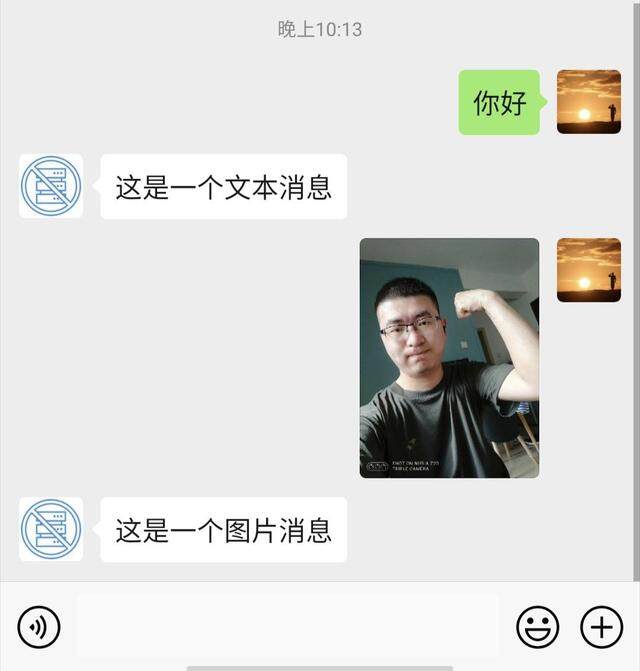
可以看到,系统已经可以正常返回。
这样一个简单的小框架或者小 Demo 的意义是什么呢?第一,可以证明我们可以很轻量的通过一个函数来实现微信公众号的后端服务,第二这些都是基础能力,我们可以在此基础上,“肆无忌惮”的添加创新力,例如:
用户传过来的是图片消息,我们可以通过一些识图API告诉用户这个图片包括了什么
用户传过来的是文字消息,我们可以先设定一些帮助信息/检索信息进行对比,如果没找到就给用户开启聊天功能(这里涉及到人工智能中的自然语言处理,例如对话、文本相似度检测等等)
如果用户发送的是语音,我们还可以将其转成文本,生成对话消息,然后再转换成语音返回给用户
如果用户发送了地理位置信息,我们可以返回给用户所在经纬度的街景信息或者周边的信息/生活服务信息等
…
使用 Werobot 框架
上面是通过 Serverless 原生开发的方法进行对接,除此之外,我们还可以选择一些已有的框架,例如werobot等。
以werobot为例:
WeRoBot 是一个微信公众号开发框架。通过 Serverless Component 中的tencent-werobot组件快速部署该框架:
Weixin_Werobot: component: "@serverless/tencent-werobot" inputs: functionName: Weixin_Werobot code: ./test werobotProjectName: app werobotAttrName: robot functionConf: timeout: 10 memorySize: 256 environment: variables: wxtoken: 你的token apigatewayConf: protocols: - http environment: release
新建代码:
import osimport werobot
robot = werobot.WeRoBot(token=os.environ.get('wxtoken'))
robot.config['SESSION_STORAGE'] = Falserobot.config["APP_ID"] = os.environ.get('appid')robot.config["APP_SECRET"] = os.environ.get('secret')
# @robot.handler 处理所有消息@robot.handlerdef hello(message): return 'Hello World!'
if __name__ == "__main__": # 让服务器监听在 0.0.0.0:80 robot.config['HOST'] = '0.0.0.0' robot.config['PORT'] = 80 robot.run()
在本地安装 werobot 相关依赖,执行部署:

把下面地址复制到公众号后台:

开启调用即可。
参考 Git:https://github.com/serverless-tencent/tencent-werobot
这里需要注意的是,我们一定要关掉 Session 或者将 Session 改成云数据库,不能使用本地文件等,例如关闭 Session 配置:
robot.config['SESSION_STORAGE'] = False
文本相似度实现图文检索
首先要说为什么要做文章搜索功能?因为用户不知道我们发了什么文章,也不清楚每个文章具体内容,他可能只需要简单的关键词来看一下这个公众号是否有他想要的东西,例如用户搜索“如何上传文件?”这样类似的简单问题,我们就可以快速把最相关的历史文章推送给用户。
先预览一下效果图:

通过这样简单的问题描述找到目标结果,表面上这是一个文章搜索功能,实际上可以把它拓展成是一种“客服系统”,甚至将其升级为一种“聊天系统”。
在之前的代码基础上,我们新增两个函数:
函数1: 索引建立函数
主要功能:通过触发该函数,将现有的公众号数据进行整理,并且建立适当的索引文件,存储到 COS 中。
# -*- coding: utf8 -*-import osimport reimport jsonimport randomfrom snownlp import SnowNLPfrom qcloud_cos_v5 import CosConfigfrom qcloud_cos_v5 import CosS3Client
bucket = os.environ.get('bucket')secret_id = os.environ.get('secret_id')secret_key = os.environ.get('secret_key')region = os.environ.get('region')client = CosS3Client(CosConfig(Region=region, SecretId=secret_id, SecretKey=secret_key))
def main_handler(event, context): response = client.get_object( Bucket=bucket, Key=event["key"], ) response['Body'].get_stream_to_file('/tmp/output.txt')
with open('/tmp/output.txt') as f: data = json.loads(f.read())
articlesIndex = [] articles = {} tempContentList = [ "_", " ", ] for eveItem in data: for i in range(0, len(eveItem['content']['news_item'])): content = eveItem['content']['news_item'][i]['content'] content = re.sub(r'<code(.*?)</code>', '_', content) content = re.sub(r'<.*?>', '', content) for eve in tempContentList: content = content.replace(eve, "") desc = "%s。%s。%s" % ( eveItem['content']['news_item'][i]['title'], eveItem['content']['news_item'][i]['digest'], "。".join(SnowNLP(content).summary(3)) ) tempKey = "".join(random.sample('zyxwvutsrqponmlkjihgfedcba', 5)) articlesIndex.append( { "media_id": tempKey, "description": desc } ) articles[tempKey] = eveItem['content']['news_item'][i]
client.put_object( Bucket=bucket, Body=json.dumps(articlesIndex).encode("utf-8"), Key=event['index_key'], EnableMD5=False ) client.put_object( Bucket=bucket, Body=json.dumps(articles).encode("utf-8"), Key=event['key'], EnableMD5=False )
这一部分定制化可能比较多一些,首先是 tempContentList 变量,可以写上一些公众号中重复且不重要的话,例如在公众号开始结尾可能有欢迎关注的文案,这些文案理论上不应该参与搜索,所以最好在建立索引的时候就替换去除。然后我们还通过上述代码去掉了 code 标签里面的内容,因为代码也会影响结果,同时也去掉了 html 标签。
原始的文件大概是这样的:
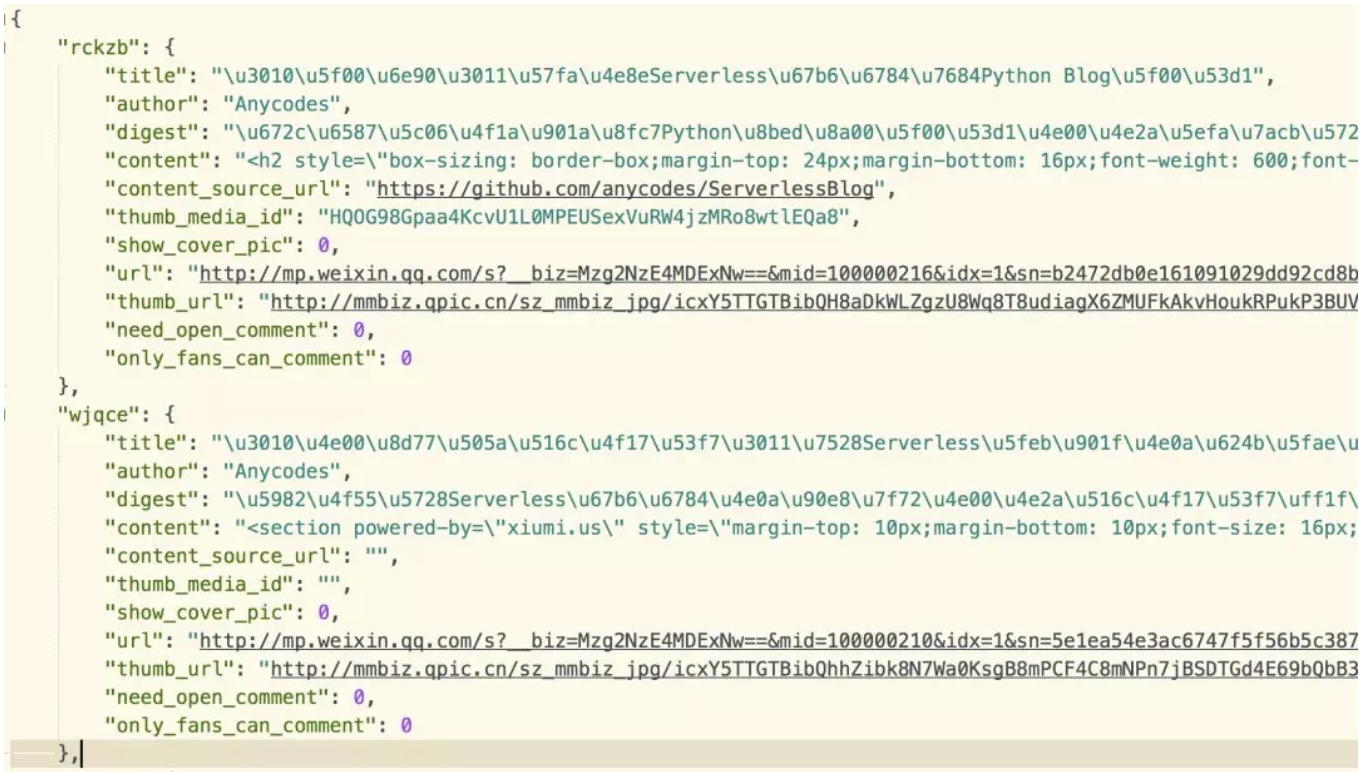
处理好的文件(通过标题+描述+SnowNLP 提取的摘要):
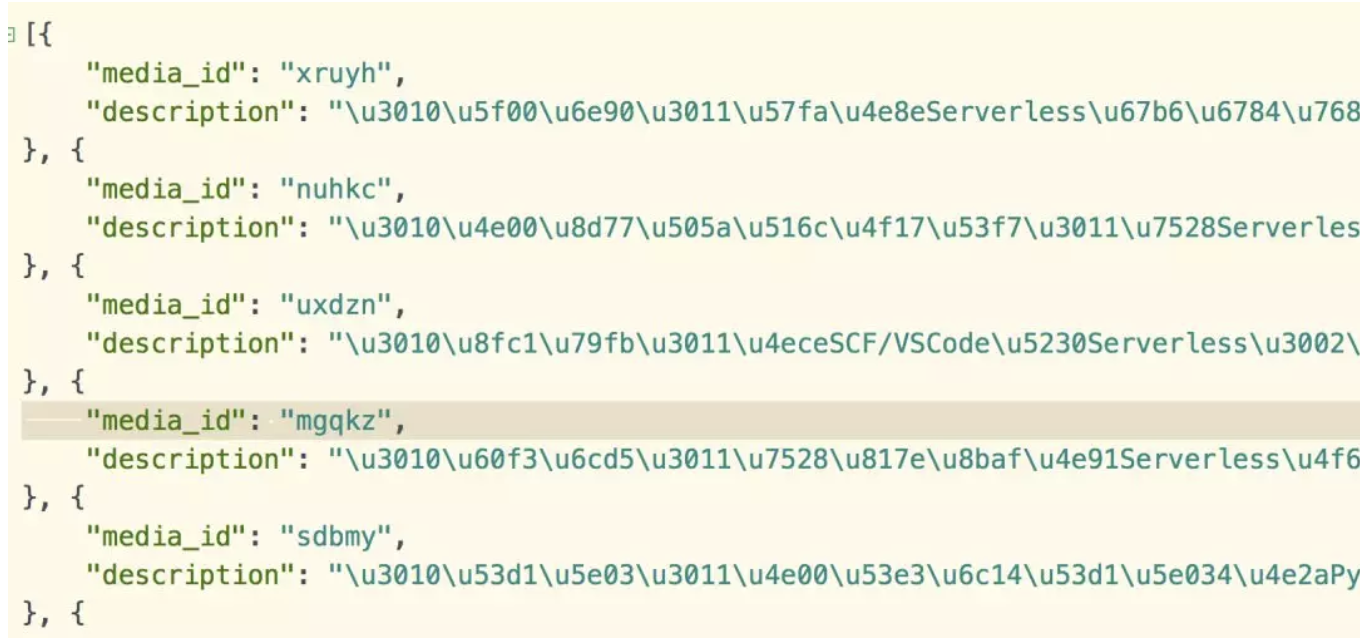
然后将这些文件存储到 COS 中,这一部分的核心就是保证提取出来的 description 尽可能地可以准确描述文章的内容。一般情况下,标题就是文章的核心,但是标题可能有一些信息丢失,例如说文章:【想法】用腾讯云 Serverless 你要知道他们两个的区别实际上描述的是 Plugin 和 Component 的区别,虽然标题知道是两个东西,但是却缺少了核心的目标,所以再加上我们下面的描述:什么是 Serverless Framework Plugin?什么是 Component?Plugin 与 Component 有什么区别?想要入门 Serverless CLI,这两个产品必须分的清楚,本文将会分享这二者区别与对应的特点、功能。当然,加上描述之后内容变得已经相当精确,但是正文中,可能有相对来说更加精准的描述或者额外的内容,所以采用的是标题+描述+摘要(textRank 提取出来的前三句,属于提取式文本)。
函数2: 搜索函数
主要功能:当用户向微信号发送了指定关键词,通过该函数获取的结果。
思考:函数 1 和函数 2,都可以集成在之前的函数中,为什么要把函数 1 和函数 2 单独拿出来做一个独立的函数存在呢?放在一个函数中不好么?
是这样的,主函数触发次数相对来说是最多的,而且这个函数本身不需要太多的资源配置(64M 就够了),而函数 1 和函数 2,可能需要消耗更多的资源,如果三个函数合并放在一起,可能函数的内存大小需要整体调大,满足三个函数需求,这样的话,相对来说会消耗更多资源,例如
主函数触发了 10 次(64M,每次 1S),函数 1 触发了 2 次(512M,每次 5S),函数 2 触发了 4 次(384M,每次 3S)
如果将三个函数放在一起,资源消耗是:

如果将其变成三个函数来执行,资源消耗是:
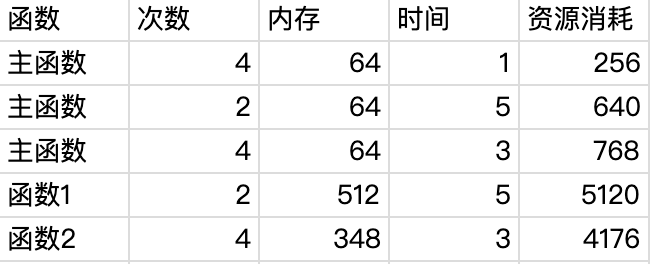
前者总计资源消耗 13308,后者 10432,随着调用次数越来越多,主函数的调用比例会越来越大,所以节约的资源也就会越来越多,所以此处建议将资源消耗差距比较大的模块,分成不同函数进行部署。
import osimport jsonimport jiebafrom qcloud_cos_v5 import CosConfigfrom qcloud_cos_v5 import CosS3Clientfrom collections import defaultdictfrom gensim import corpora, models, similarities
bucket = os.environ.get('bucket')secret_id = os.environ.get('secret_id')secret_key = os.environ.get('secret_key')region = os.environ.get('region')client = CosS3Client(CosConfig(Region=region, SecretId=secret_id, SecretKey=secret_key))
def main_handler(event, context): response = client.get_object( Bucket=bucket, Key=event["key"], ) response['Body'].get_stream_to_file('/tmp/output.txt')
with open('/tmp/output.txt') as f: data = json.loads(f.read())
articles = [] articlesDict = {} for eve in data: articles.append(eve['description']) articlesDict[eve['description']] = eve['media_id']
sentence = event["sentence"]
documents = [] for eve_sentence in articles: tempData = " ".join(jieba.cut(eve_sentence)) documents.append(tempData) texts = [[word for word in document.split()] for document in documents] frequency = defaultdict(int) for text in texts: for word in text: frequency[word] += 1 dictionary = corpora.Dictionary(texts) new_xs = dictionary.doc2bow(jieba.cut(sentence)) corpus = [dictionary.doc2bow(text) for text in texts] tfidf = models.TfidfModel(corpus) featurenum = len(dictionary.token2id.keys()) sim = similarities.SparseMatrixSimilarity( tfidf[corpus], num_features=featurenum )[tfidf[new_xs]] answer_list = [(sim[i], articles[i]) for i in range(1, len(articles))] answer_list.sort(key=lambda x: x[0], reverse=True) result = [] print(answer_list) for eve in answer_list: if eve[0] > 0.10: result.append(articlesDict[eve[1]]) if len(result) >= 8: result = result[0:8] return {"result": json.dumps(result)}
这一部分的代码也是很简单,主要是通过文本的相似度对每个文本进行评分,然后按照评分从高到低进行排序,给定一个阈值(此处设定的阈值为 0.1),输出阈值之前的数据。
另外这里要注意,此处引用了两个依赖是 jieba 和 gensim,这两个依赖都可能涉及到二进制文件,所以强烈推荐在 CentOS 系统下进行打包。
接下来就是主函数中的调用,为了实现上述功能,需要在主函数中新增方法:
1: 获取全部图文消息
def getTheTotalOfAllMaterials(): ''' 文档地址:https://developers.weixin.qq.com/doc/offiaccount/Asset_Management/Get_the_total_of_all_materials.html :return: ''' accessToken = getAccessToken() if not accessToken: return "Get Access Token Error" url = "https://api.weixin.qq.com/cgi-bin/material/get_materialcount?access_token=%s" % accessToken responseAttr = urllib.request.urlopen(url=url) return json.loads(responseAttr.read())
def getMaterialsList(listType, count): ''' 文档地址:https://developers.weixin.qq.com/doc/offiaccount/Asset_Management/Get_materials_list.html :return: ''' accessToken = getAccessToken() if not accessToken: return "Get Access Token Error"
url = "https://api.weixin.qq.com/cgi-bin/material/batchget_material?access_token=%s" % accessToken materialsList = [] for i in range(1, int(count / 20) + 2): requestAttr = urllib.request.Request(url=url, data=json.dumps({ "type": listType, "offset": 20 * (i - 1), "count": 20 }).encode("utf-8"), headers={ "Content-Type": "application/json" }) responseAttr = urllib.request.urlopen(requestAttr) responseData = json.loads(responseAttr.read().decode("utf-8")) materialsList = materialsList + responseData["item"] return materialsList
可以通过以下代码调用:
rticlesList = getMaterialsList("news", getTheTotalOfAllMaterials()['news_count'])
2: 将图文消息存储到 COS,并且通过函数的 Invoke 接口,实现函数间调用:
def saveNewsToCos(): global articlesList articlesList = getMaterialsList("news", getTheTotalOfAllMaterials()['news_count']) try: cosClient.put_object( Bucket=bucket, Body=json.dumps(articlesList).encode("utf-8"), Key=key, EnableMD5=False ) req = models.InvokeRequest() params = '{"FunctionName":"Weixin_GoServerless_GetIndexFile", "ClientContext":"{\\"key\\": \\"%s\\", \\"index_key\\": \\"%s\\"}"}' % ( key, indexKey) req.from_json_string(params) resp = scfClient.Invoke(req) resp.to_json_string() response = cosClient.get_object( Bucket=bucket, Key=key, ) response['Body'].get_stream_to_file('/tmp/content.json') with open('/tmp/content.json') as f: articlesList = json.loads(f.read()) return True except Exception as e: print(e) return False
3: 根据搜索反馈回来的 Key 实现文章内容的对应
def searchNews(sentence): req = models.InvokeRequest() params = '{"FunctionName":"Weixin_GoServerless_SearchNews", "ClientContext":"{\\"sentence\\": \\"%s\\", \\"key\\": \\"%s\\"}"}' % ( sentence, indexKey) req.from_json_string(params) resp = scfClient.Invoke(req) print(json.loads(json.loads(resp.to_json_string())['Result']["RetMsg"])) media_id = json.loads(json.loads(json.loads(resp.to_json_string())['Result']["RetMsg"])["result"]) return media_id if media_id else None
最后在 main_handler 中,增加使用逻辑:
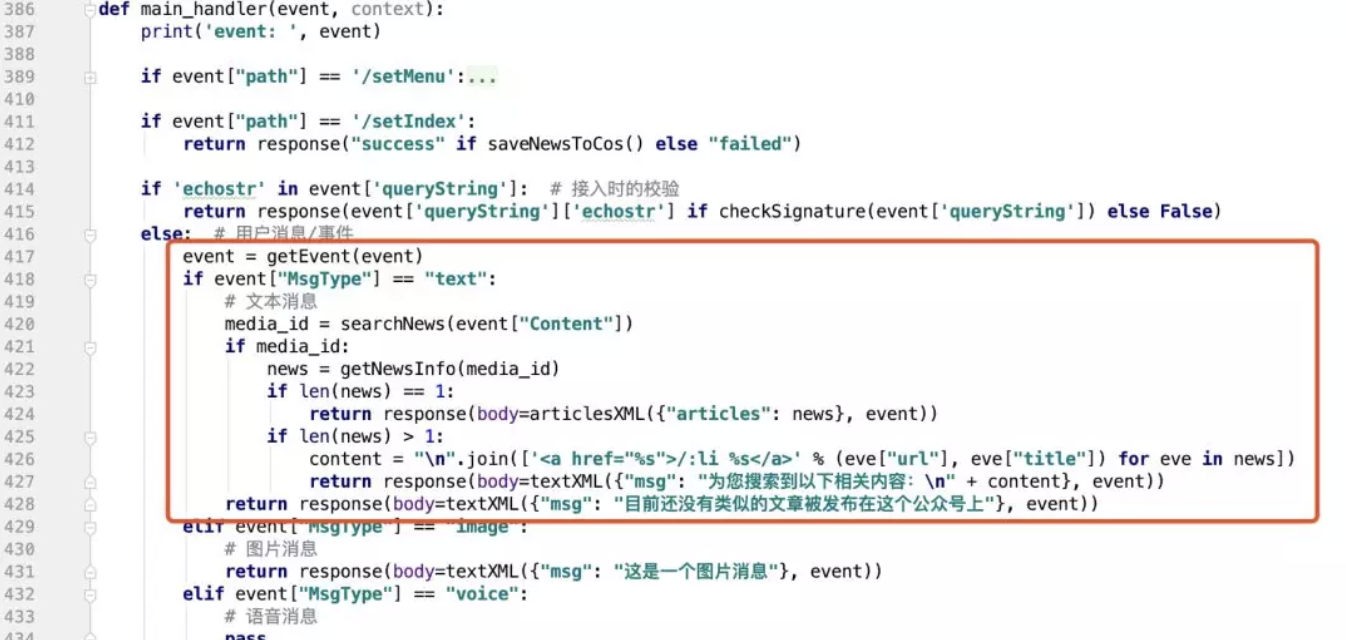
逻辑很简单,就是根据用户发的消息去查找对应的结果,拿到结果之后判断结果个数,如果有 1 个相似内容,则返回一个图文,如果有多个则返回带有链接的文本。
另外一个逻辑是建立索引,直接通过 API 网关触发即可,当然,如果怕不安全或者有需要的话,可以增加权限鉴定的参数:

额外优化:
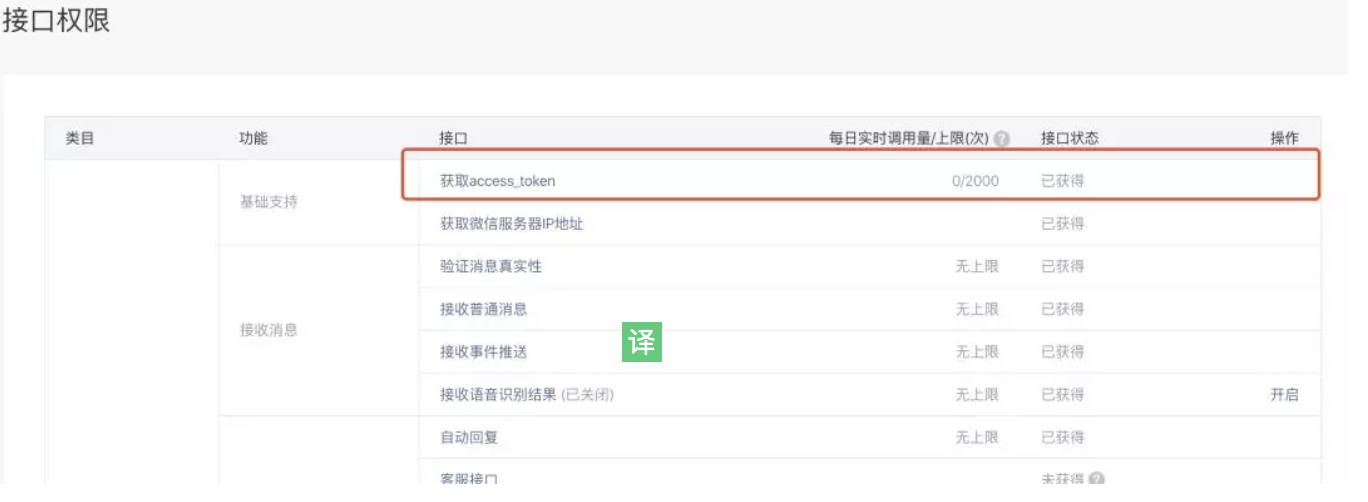
在接口列表中,我们可以看到获取 accessToken 的接口实际上是有次数限制的,每次获取有效期两个小时。所以,我们就要在函数中对这部分内容做持久化。为了实现这个功能,使用 MySQL 貌似不是很划算,所以我们决定用 COS:
def getAccessToken(): ''' 文档地址:https://developers.weixin.qq.com/doc/offiaccount/Basic_Information/Get_access_token.html 正常返回:{"access_token":"ACCESS_TOKEN","expires_in":7200} 异常返回:{"errcode":40013,"errmsg":"invalid appid"} :return: ''' global accessToken
# 第一次判断是判断本地是否已经有了accessToken,考虑到容器复用情况 if accessToken: if int(time.time()) - int(accessToken["time"]) <= 7000: return accessToken["access_token"]
# 如果本地没有accessToken,可以去cos获取 try: response = cosClient.get_object( Bucket=bucket, Key=accessTokenKey, ) response['Body'].get_stream_to_file('/tmp/token.json') with open('/tmp/token.json') as f: accessToken = json.loads(f.read()) except: pass
# 这一次是看cos中是否有,如果cos中有的话,再次进行判断段 if accessToken: if int(time.time()) - int(accessToken["time"]) <= 7000: return accessToken["access_token"]
# 如果此时流程还没停止,则说明accessToken还没获得到,就需要从接口获得,并且同步给cos url = "https://api.weixin.qq.com/cgi-bin/token?grant_type=client_credential&appid=%s&secret=%s" % (appid, secret) accessTokenResult = json.loads(urllib.request.urlopen(url).read().decode("utf-8")) accessToken = {"time": int(time.time()), "access_token": accessTokenResult["access_token"]} print(accessToken) response = cosClient.put_object( Bucket=bucket, Body=json.dumps(accessToken).encode("utf-8"), Key=accessTokenKey, EnableMD5=False ) return None if "errcode" in accessToken else accessToken["access_token"]
当然,我觉得这段代码可以继续优化,但是目前这个算是一个思路。
为公众号增加机器人功能
上文我们已经完成了公众号的基本框架的搭建,也完成了基于 NLP 知识的图文检索功能,可以说之前的内容都是原生开发,无论是公众号基础能力建设还是图文检索能力,而现在我们将在之前的基础上,通过云服务商提供的 AI 能力,将智能聊天功能接入其中。
首先假设一个场景:用户关注这个公众号之后,他给公众号发送文本消息,我们首先进行图文检索,如果没找到合适的结果,就默认进入“聊天功能”;如果用户发送了语音,我们同样先进行图文检索,如果没有找得到相似图文,则通过语音进入“聊天功能”,这样看来是不是整个功能变得非常有趣?
首先整体看一下机器人功能的基本形态:
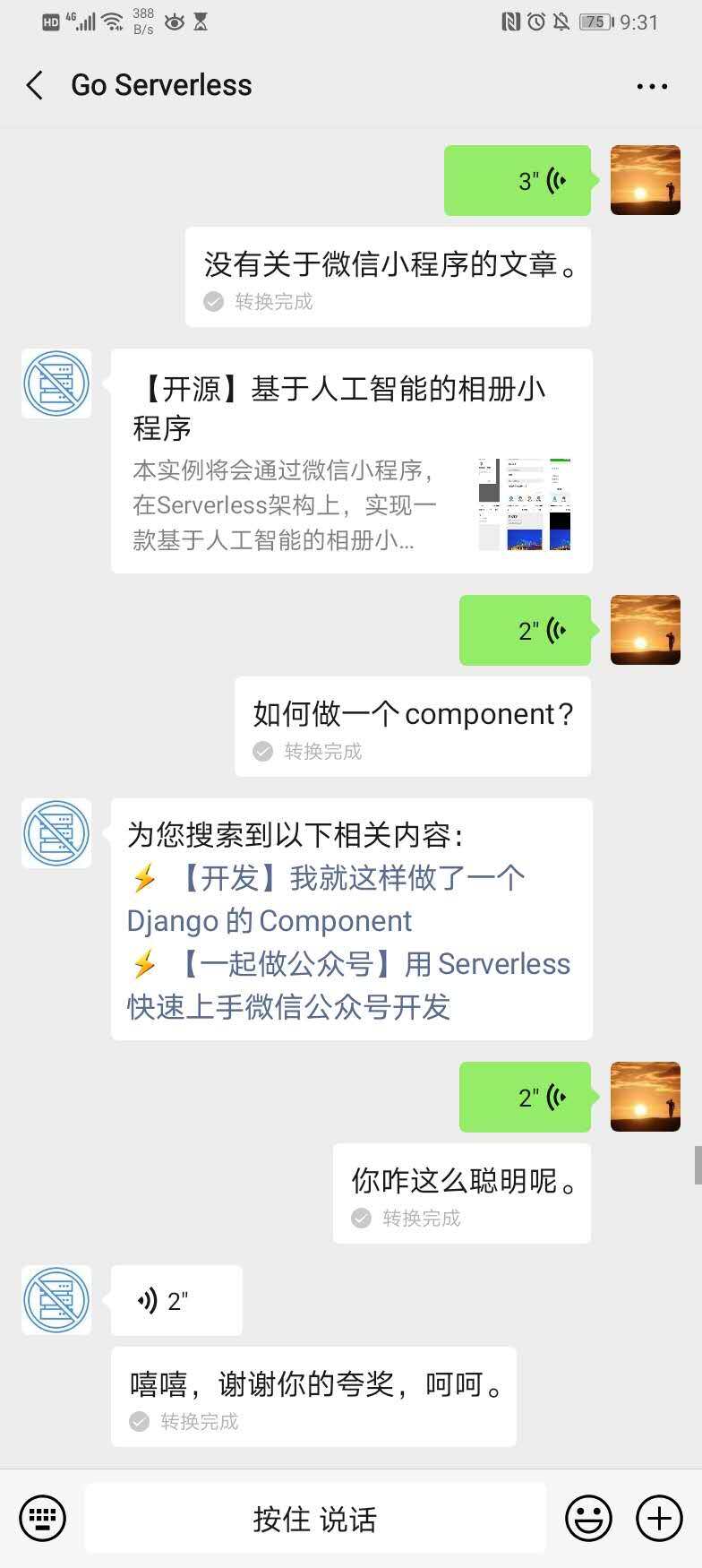
聊天功能增加
聊天功能我们可以借助云厂商提供的聊天机器人服务:

开通和使用这个服务,可以为我们创建一个简单的机器人:
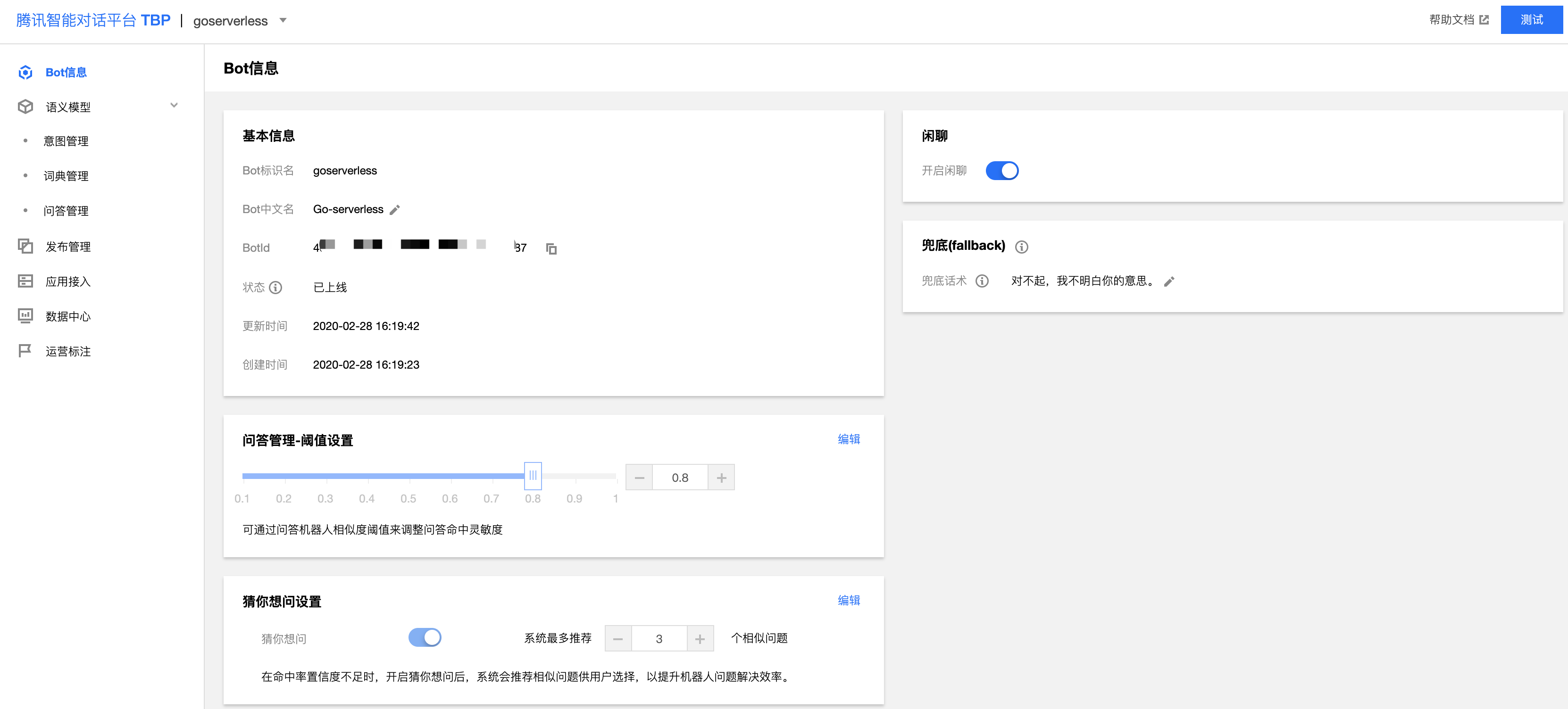
创建完成机器人,我们可以通过云 API 对其进行代码的编写,云 API 代码比较难写也不怕,有 API Explorer,系统会为我们自动编写好基本的代码,我们只需要稍加修改,就可以复制到项目中。
在最外层进行相关初始化:
tbpClient = tbp_client.TbpClient(credential.Credential(secret_id, secret_key), region)
初始化完成,增加聊天机器人函数:
def chatBot(user, content): ''' 开发文档:https://cloud.tencent.com/document/product/1060/37438 :param user: 用户id :param content: 聊天内容 :return: 返回机器人说的话,如果出现故障返回None ''' try: req = tbp_models.TextProcessRequest() params = '{"BotId":"%s","BotEnv":"release","TerminalId":"%s","InputText":"%s"}' % ( bot_id, user, content ) req.from_json_string(params) resp = tbpClient.TextProcess(req) return json.loads(resp.to_json_string())['ResponseMessage']['GroupList'][0]['Content'] except Exception as e: print(e) return None
文本转音频功能增加
同样的方法,这不过是使用的另一个产品:

同样通过 Explorer 编写代码,然后初始化:
ttsClient = tts_client.TtsClient(credential.Credential(secret_id, secret_key), region)
增加相关的方法实现文本到函数的转换:
def text2Voice(text): ''' 文档地址:https://cloud.tencent.com/document/product/1073/37995 :param text: 带转换的文本 :return: 返回转换后的文件地址 ''' try: req = tts_models.TextToVoiceRequest() params = '{"Text":"%s","SessionId":"%s","ModelType":1,"VoiceType":1002}' % ( text, "".join(random.sample('zyxwvutsrqponmlkjihgfedcba', 7))) req.from_json_string(params) resp = ttsClient.TextToVoice(req) file = '/tmp/' + "".join(random.sample('zyxwvutsrqponmlkjihgfedcba', 7)) + ".wav" with open(file, 'wb') as f: f.write(base64.b64decode(json.loads(resp.to_json_string())["Audio"])) return file
except Exception as e: print(e) return None
增加微信的素材相关逻辑
由于我的账号是未认证的订阅号,所以可以使用的功能有限。在这里我需要先将生成的语音素材上传到公众号后台作为永久素材。因为语音类素材最大量为 1000 个,所以我还要顺便删除多余的素材。
此处我的做法很简单,先上传素材,然后获得素材总数,接下来根据素材中的时间戳:
{ 'media_id': 'HQOG98Gpaa4KcvU1L0MPEW4Zvngs4kBqOyTRzNWBNME', 'name': 'ljpmybc.wav', 'update_time': 1582896372, 'tags': []}
就是update_time这个参数,和现在的时间进行判断,超过 60S 则认为这个素材已经过期,就可以删除,这样保证我们的素材数量不会溢出:
增加永久素材:
def addingOtherPermanentAssets(file, fileType): ''' 文档地址:https://developers.weixin.qq.com/doc/offiaccount/Asset_Management/Adding_Permanent_Assets.html 返回结果:{ "media_id":"HQOG98Gpaa4KcvU1L0MPEcyy31LSuHhRi8gD3pvebhI", "url":"http:\/\/mmbiz.qpic.cn\/sz_mmbiz_png\/icxY5TTGTBibSyZPfLAEZmeaicUczsoGUpqLgBlRbNxeic4R8r94j60BiaxDLEZTAK7I7qubG3Ik808P8jYLdFJTcOA\/0?wx_fmt=png", "item":[] } :param file: :return: ''' typeDict = { "voice": "wav" } url = "https://api.weixin.qq.com/cgi-bin/material/add_material?access_token=%s&type=%s" % ( getAccessToken(), fileType) boundary = '----WebKitFormBoundary7MA4YWxk%s' % "".join(random.sample('zyxwvutsrqponmlkjihgfedcba', 7)) with open(file, 'rb') as f: fileData = f.read() data = {'media': (os.path.split(file)[1], fileData, typeDict[fileType])} headers = { "Content-Type": "multipart/form-data; boundary=%s" % boundary, "User-Agent": "okhttp/3.10.0" } reqAttr = urllib.request.Request(url=url, data=encode_multipart_formdata(data, boundary=boundary)[0], headers=headers) responseData = json.loads(urllib.request.urlopen(reqAttr).read().decode("utf-8"))
try: for eveVoice in getMaterialsList("voice", getTheTotalOfAllMaterials()['voice_count']): try: if int(time.time()) - int(eveVoice["update_time"]) > 60: deletingPermanentAssets(eveVoice['media_id']) except: pass except: pass
return responseData['media_id'] if "media_id" in responseData else None
删除素材:
def deletingPermanentAssets(media_id): ''' 文档地址:https://developers.weixin.qq.com/doc/offiaccount/Asset_Management/Deleting_Permanent_Assets.html :return: ''' url = 'https://api.weixin.qq.com/cgi-bin/material/del_material?access_token=%s' % (getAccessToken()) data = { "media_id": media_id } postData = json.dumps(data).encode("utf-8") reqAttr = urllib.request.Request(url=url, data=postData) print(urllib.request.urlopen(reqAttr).read())
至此,基础代码已经完成,剩下的逻辑就是在 main_handler 中进行组合:
文本消息部分的组合逻辑:
media_id = searchNews(event["Content"])result = getNewsResult(media_id, event)if not result: chatBotResponse = chatBot(event["FromUserName"], event["Content"]) result = textXML({"msg": chatBotResponse if chatBotResponse else "目前还没有类似的文章被发布在这个公众号上"}, event) return response(body=result)
语音消息部分组合逻辑:
media_id = searchNews(event["Recognition"])result = getNewsResult(media_id, event)if not result: chatBotResponse = chatBot(event["FromUserName"], event["Recognition"]) if chatBotResponse: voiceFile = text2Voice(chatBotResponse) if voiceFile: uploadResult = addingOtherPermanentAssets(voiceFile, 'voice') if uploadResult: result = voiceXML({"media_id": uploadResult}, event)if not result: result = textXML({"msg": "目前还没有类似的文章被发布在这个公众号上"}, event)return response(body=result)
总结
至此,我们完成了一个简单的公众号开发。通过 Serverless 的原生开发思路(也可以使用 Werobot 等公众号开发框架),将公众号后台服务部署到 Serverless 架构上,通过自然语言处理技术(特指文本相似度等)实现了一个图文检索功能;通过与云厂商提供的 AI 能力结合,实现了一个聊天机器人,可以进行文本交流,也可以进行语音沟通。
更多内容推荐
使用京东云搭建视频直播网站
视频直播是指利用互联网及流媒体技术进行直播,视频因融合了图像、文字、声音等丰富元素,声形并茂,效果极佳,逐渐成为互联网的主流表达方式。
百度开放云骑士之夜:“基于百度开放云的营销插件平台”的作品简析
在6号的百度开放云骑士之夜的活动中,有幸在36小时的编码之后获得了比赛的一等奖,这里写下自己在整个比赛中的感受以及作品的技术选型方案。
10 丨 Python 爬虫:如何自动化下载王祖贤海报?
相比于使用第三方工具,Python爬虫都有哪些长处?
2019 年 1 月 4 日
第 15 讲 | 如何载入背景音乐和音效?
在游戏中载入背景音乐和音效需要用到哪些函数?播放音乐需不需要多线程控制?
2018 年 7 月 5 日
Serverless 实战:通过 Serverless 架构实现监控告警
Serverless 服务的一个重要应用场景就是运维、监控与告警,所以本文将会通过现有的 Serverless 平台,部署一个网站状态监控脚本,对目标网站的可用性进行监控告警。
AI 智能客服小程序·云开发实践(上)
9月21日,云+社区技术沙龙“小程序·云开发”北京站圆满落幕。本期沙龙腾讯云联合猫眼、即速应用、白鹭引擎等企业,将从小程序·云开发后台技术、云开发实时数据推送实践、云开发AI智能客服实践等方面揭秘云开发应用实践,带来更多技术实战分享。
博文共赏:Android 推送服务——百度云推送
消息推送,顾名思义,是由一方主动发起,而另一方与发起方以某一种方式建立连接并接收消息。Android生态系统原本提供了类似于Apple iOS推送服务APNS的GCM(Google Cloud Messaging for Android),以前叫C2DM,但是由于某些原因,导致这项服务在国内不是很好使,所以国内各大平台陆续推出了GCM的替代品,今天要介绍的就是其中一家,由百度提供的云推送。
从 0 到 1:你的第一个 GUI 自动化测试
我基于Selenium 2.0,带你从0到1建立了一个GUI自动化测试用例。这个用例的实现很简单,但是只有真正理解了这个工具的原理,你才能真正用好它。
2018 年 7 月 25 日
Serverless 实践系列(六):云函数 +API,告知天气信息
本文通过简单的例子实现云函数SCF与API网关的结合
如何搭建小型视频点播网站
视频点播就是把用户所点击或选择的视频内容,传输给所请求的用户。
如何在 Serverless 架构下优雅上传文件?
Serverless可以看作是一个新的技术、新的架构。我们在接触新鲜事物的时候,或多或少都要有一个适应期,如何在Serverless架构下上传文件,就是需要适应的部分。
实战演练:通过 WebRTC 实现一个 1 对 1 音视频实时直播系统
通过本文的“串联”,你就可以自己实现一个真正的 1 对 1 的实时音视频直播系统了。
2019 年 9 月 5 日
结课问卷获奖用户名单
每一个声音都值得倾听,感谢你们,与我们共创内容!
2020 年 12 月 16 日
Ticketmaster 提供 API,开放第三方售票功能
今年3月底,Ticketmaster在其开发者网站上发布了一套面向公众的应用程序接口(API)、网页控件,并将推出一套移动开发的SDK供开发者集成,成功加入了开放API的行列。
小程序最佳实践,五步拆解小程序·云开发的技术生态
随着小程序·云开发的能力在前段时间得到了进一步增强,在简化开发者操作的同时,以业务场景为入口,为开发者提供无需技术底层架构能力即可构建功能完善小程序的能力,借助云开发的能力,进一步优化了小程序开发的体验。
Serverless 实战:如何为你的头像增加点装饰?
每到大型节假日,我们常会发现社交平台都会提供生成头像装饰的小工具,很是新奇好玩。
编写第一个 Spring MVC Controller
2019 年 3 月 12 日
Serverless 实战:利用触发器定制一个专属的企业微信机器人
利用定时触发器可以快速建立一个企业微信机器人,我们可以在这个机器人中实现很多定制化的功能,例如按时提醒我们喝水吃饭、定时推送新闻天气、实现监控告警等等。
手把手教你如何用 Lambda + Alexa 调用 echo 设备
AWS Lambda在可用性高的计算基础设施上运行您的代码
推荐阅读
如何使用 Medooze 实现多方视频会议?
2019 年 9 月 19 日
Google 发布用于 Google Glass 的 Mirror API
SQL 注入实战:玩转 sqlmap 之携带 cookie
2020 年 8 月 20 日
基于 Serverless 重构编程学习小工具
Serverless 实战:利用函数计算与对象存储实现 WordCount
基于 Next.js 和云开发 CMS 的内容型网站应用实战开发
如何构造酷炫的物理效果和过场动画效果?
2019 年 5 月 2 日
电子书
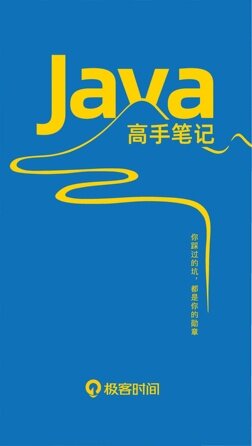
大厂实战PPT下载
换一换 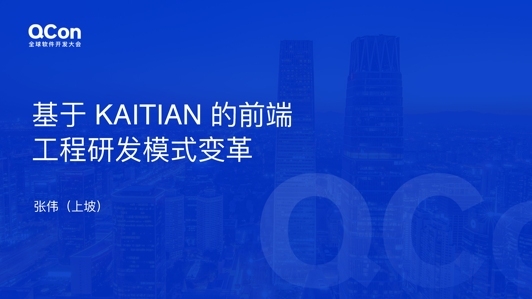
张伟(上坡) | 阿里巴巴 阿里巴巴前端技术专家
刘超 | 极客时间 《趣谈互联网协议》专栏作者
钟黎 | 腾讯 知文技术负责人











评论